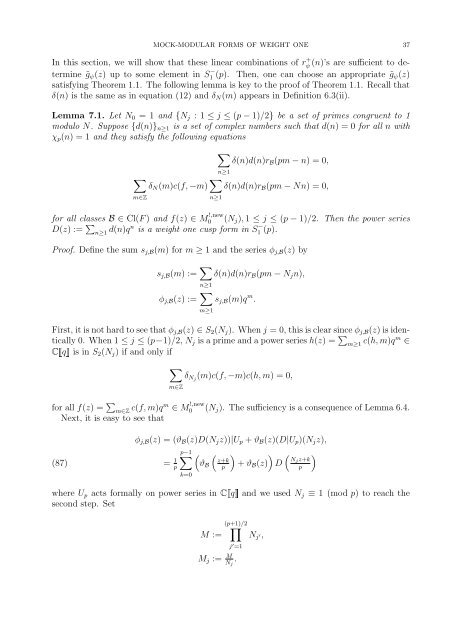Mock-modular forms of weight one - UCLA Department of Mathematics
Mock-modular forms of weight one - UCLA Department of Mathematics
Mock-modular forms of weight one - UCLA Department of Mathematics
You also want an ePaper? Increase the reach of your titles
YUMPU automatically turns print PDFs into web optimized ePapers that Google loves.
MOCK-MODULAR FORMS OF WEIGHT ONE 37<br />
In this section, we will show that these linear combinations <strong>of</strong> r + ψ<br />
(n)’s are sufficient to determine<br />
˜g ψ (z) up to some element in S1 − (p). Then, <strong>one</strong> can choose an appropriate ˜g ψ (z)<br />
satisfying Theorem 1.1. The following lemma is key to the pro<strong>of</strong> <strong>of</strong> Theorem 1.1. Recall that<br />
δ(n) is the same as in equation (12) and δ N (m) appears in Definition 6.3(ii).<br />
Lemma 7.1. Let N 0 = 1 and {N j : 1 ≤ j ≤ (p − 1)/2} be a set <strong>of</strong> primes congruent to 1<br />
modulo N. Suppose {d(n)} n≥1 is a set <strong>of</strong> complex numbers such that d(n) = 0 for all n with<br />
χ p (n) = 1 and they satisfy the following equations<br />
∑<br />
m∈Z<br />
δ N (m)c(f, −m) ∑ n≥1<br />
∑<br />
δ(n)d(n)r B (pm − n) = 0,<br />
n≥1<br />
δ(n)d(n)r B (pm − Nn) = 0,<br />
for all classes B ∈ Cl(F ) and f(z) ∈ M !,new<br />
0 (N j ), 1 ≤ j ≤ (p − 1)/2. Then the power series<br />
D(z) := ∑ n≥1 d(n)qn is a <strong>weight</strong> <strong>one</strong> cusp form in S − 1 (p).<br />
Pro<strong>of</strong>. Define the sum s j,B (m) for m ≥ 1 and the series φ j,B (z) by<br />
s j,B (m) := ∑ n≥1<br />
φ j,B (z) := ∑ m≥1<br />
s j,B (m)q m .<br />
δ(n)d(n)r B (pm − N j n),<br />
First, it is not hard to see that φ j,B (z) ∈ S 2 (N j ). When j = 0, this is clear since φ j,B (z) is identically<br />
0. When 1 ≤ j ≤ (p−1)/2, N j is a prime and a power series h(z) = ∑ m≥1 c(h, m)qm ∈<br />
CJqK is in S 2 (N j ) if and only if<br />
∑<br />
δ Nj (m)c(f, −m)c(h, m) = 0,<br />
m∈Z<br />
for all f(z) = ∑ m∈Z c(f, m)qm ∈ M !,new<br />
0 (N j ). The sufficiency is a consequence <strong>of</strong> Lemma 6.4.<br />
Next, it is easy to see that<br />
(87)<br />
φ j,B (z) = (ϑ B (z)D(N j z))|U p + ϑ B (z)(D|U p )(N j z),<br />
= 1 p<br />
k=0<br />
p−1<br />
∑ ( (ϑ B<br />
) )<br />
z+k<br />
+ ϑ<br />
p B (z) D<br />
(<br />
Nj z+k<br />
p<br />
)<br />
where U p acts formally on power series in CJqK and we used N j ≡ 1 (mod p) to reach the<br />
second step. Set<br />
M :=<br />
(p+1)/2<br />
∏<br />
j ′ =1<br />
M j := M N j<br />
.<br />
N j ′,
















